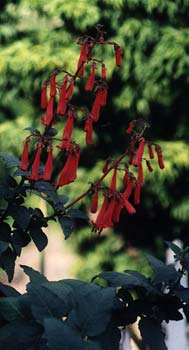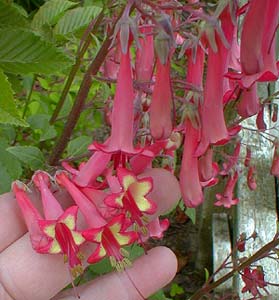
'Pink Elf'
Cape Fuchsia
"More than anything I must have flowers, always, always."
-Claude Monet
(1840-1926)
(1840-1926)
Cape Fuchsias are not true fuchsias, but are related to foxgloves. In temperate climates they are vastly more garden-hardy than the majority of true fuchsias. They require sun & relatively persistent moisture in rich acidic soil, & can do with almost-monthly doses of liquid fertilizer while in bloom. Once well established they are a lot more drought-tolerant than one would guess. They are great butterfly attractants & are often pollinated by hummingbirds.
'Pink Elf' Cape fuchsia, shown here in June photos from 2002 & 2003 respectively, is a hybridization of two South African species, Phygelius aequalis & P. capensis, sold as Phygelius x rectus 'Pink Elf.'
 From late May until first frost or about September, it produces numerous dangling dusty-pink tubular blossoms which on the interior are very yellow with deeper red edge. It is usually only three to four feet tall, but ours produces the occasional stem of blossoms that rise to five feet. It forms a narrowly compact leafy shrub rarely as wide as it is tall.
From late May until first frost or about September, it produces numerous dangling dusty-pink tubular blossoms which on the interior are very yellow with deeper red edge. It is usually only three to four feet tall, but ours produces the occasional stem of blossoms that rise to five feet. It forms a narrowly compact leafy shrub rarely as wide as it is tall.The Pink Elf is planted underneath a Hornbeam Tree between a golden-leafed Fuchsia magellanica 'Aurea' & the Azalea 'Apricot Surprise.'
The surrounding shrubs protect it from harsh winds, but it still gets considerable afternoon sunlight. Though in warmer places fuchsias tolerate or even prefer a goodly amount of shade, in our temperate zone Cape fuchsia does better in a sunny location, so long as it is not exposed to winter winds.
It is nearly evergreen on Puget Sound, & looks fresh & bright right up through January. But sometimes its leaves are pretty beaten up just as spring begins, or will begin to get spotty about the time new foliage is appearing. So the old foliage is best cut back about two-thirds immediately before new spring growth.
In colder areas than ours it will not be evergreen. It will die back by late autumn, but return like any hardy perennial if winter temperatures never fell below zero.
See also the much larger cultivar
'Winchester Fanfare' Cape Fuchsia.
'Winchester Fanfare' Cape Fuchsia.